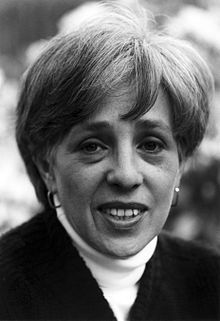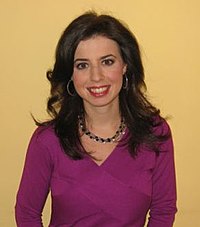Maxine Singer
Maxine Frank Singer | |
|---|---|
 | |
| Born | February 15, 1931 |
| Nationality | American |
| Alma mater | Swarthmore College (A.B.) (1952) Yale University (Ph.D) (1957) |
| Known for | Recombinant DNA techniques |
| Awards | AAAS Award for Scientific Freedom and Responsibility (1982) National Medal of Science (1992) Vannevar Bush Award (1999) Public Welfare Medal (2007) ASCB Public Service Award (2008) |
| Scientific career | |
| Fields | Molecular Biology Biochemistry |
| Doctoral advisor | Joseph Fruton |
Maxine Frank Singer (born February 15, 1931) is an American molecular biologist and science administrator.[1] She is known for her contributions to solving the genetic code, her role in the ethical and regulatory debates on recombinant DNA techniques (including the organization of the Asilomar Conference on Recombinant DNA), and her leadership of Carnegie Institution of Washington. In 2002, Discover magazine recognized her as one of the 50 most important women in science.[2]
Life
Singer was born in New York City.[3] After attending Midwood High School in Brooklyn,[4] she majored in chemistry (and minored in biology) at Swarthmore College.[5] She went on to earn a Ph.D. in 1957 at Yale University, researching protein chemistry under Joseph Fruton. Fruton encouraged her to specialize in nucleic acids, and in 1956 she joined the Laboratory of Biochemistry of Leon Heppel at the National Institutes of Health.[6] She led various biochemical research groups as the Chief of the Laboratory of Biochemistry at the National Cancer institute between 1980 and 1987.[7]
In the wake of the 1973 report of the first use of recombinant DNA techniques to introduce genes from one species into another, Singer was among the first to call attention to the possible risks of genetic engineering. She was a chairperson of the 1973 Gordon Conference on Nucleic Acids, where the possible public health risks of the technique were discussed,[8] and she helped to organize the 1975 Asilomar Conference on Recombinant DNA that resulted in guidelines for dealing with the largely unknown risks of the technique.[1]
싱어는 1978년 미국 예술 과학 아카데미 회원으로 선출되었다.[9] 1988년 그녀는 2002년까지 재임했던 워싱턴 카네기 연구소의 총장이 되었다.[10] 싱어는 1992년 '과학자의 뛰어난 과학적 업적과 사회적 책임에 대한 깊은 관심'[11]으로 국가과학훈장을 받았고 1999년 여성 최초로 '바네바 부시상'을 받았다.[12] 2007년에 그녀는 국립과학원으로부터 공공복지훈장을 받았다.[13]
연구기여금
싱어는 생화학 및 분자생물학 분야에 중요한 공헌을 하였다. 핵산의 합성을 조절하는 효소의 역할에 대한 레온 헤펠과의 연구는 마샬 니렌버그와 하인릭 마태이의 유전자 코드 해독을 돕는 데 한 몫을 했다.[14] 그들은 개별 뉴클레오티드를 무작위 RNA 시퀀스에 결합시킬 수 있는 효소인 폴리뉴클레오티드 인산화효소를 연구했다. 그들은 전기영양과 종이 크로마토그래피를 사용하여 이러한 폴리뉴클레오티드의 기본 구성을 조사했는데, 이것은 효소가 어떻게 그들의 합성을 촉진하는지 이해할 수 있게 했다.[14] 이 실험들은 또한 페닐알라닌을 암호화할 요람의 세 쌍만으로 이루어진 분자와 같은 정의된 시퀀스의 인공 RNA 가닥의 라이브러리를 만들 수 있게 했다. 이러한 인공 다핵화물은 RNA가 DNA로부터 얻은 정보를 이용하여 단백질을 합성하는 데 핵심적인 역할을 한다는 가설을 뒷받침하기 위해 니렌베르크에 의해 사용되었다. 싱어가 생산한 특정 RNA 시퀀스는 20개의 아미노산 각각을 특정 RNA 뉴클레오티드 트리플릿에 [14]일치시키기 위해 사용되었다.
가수의 연구에는 또한 바이러스의 염색질 구조와 유전적 재조합에 대한 연구도 포함되어 있다. 1980년대 국립 암 연구소의 생화학 연구소장으로 재직하면서 그녀는 LINEs, 즉 오랫동안 분열된 뉴클레오티드 원소에 연구를 집중했다.[14] 그녀는 인간 게놈의 수천 군데에 흩어져 있는 포유류 게놈에서 발견되는 역트랜스포존인 LINE-1에 초점을 맞췄는데, 이 유전자가 염색체 DNA의 새로운 위치에 이동과 삽입이 가능하다고 결론지었다.[15] 그녀는 LINE-1이 어떻게 복제하여 게놈의 새로운 위치에 복제하여 분산시키는지의 메커니즘을 연구했고, 이러한 원소를 새로운 위치에 삽입하면 인근 유전자의 돌연변이를 유도하여 유전병의 한 역할을 할 수 있다는 것을 발견했다.[14]
Contributions to scientific community
Besides her scientific research, Singer has been influential in refining science policy. When she was the co-chair of the Gordon Conference in 1973, she raised concerns over the potential health effects and risks in the relatively new field of recombinant DNA technology.[7] She organized the 1975 Asilomar conference in order to bring together scientists to impose restrictions and draw guidelines on recombinant DNA research, where she recommended resumption of research under cautious safeguards until more was known about the potential biohazards of recombinant DNA technology.[16][17]
Singer is also an advocate for women in science. She wrote an editorial in Science arguing that universities should encourage women pursuing science and engineering rather than wasting their skills due to unintentional bias against them.[18] Singer also introduced the "First Light" project, a science education program for elementary school students in Washington, D.C. aiming to improve mathematics and science education in schools.[7]
Singer has written over 100 scientific papers, and has also published several books with co-author Paul Berg intended to help the public have a better understanding of molecular genetics, including Genes and Genomes (1991), Dealing with Genes (1993), and George Beadle: An Uncommon Farmer (2003).[17] In 2018 she published Blossoms: And the Genes that Make Them which describes the genetic and evolutionary reasons behind why flowers bloom.[19]
References
- ^ a b "Profiles in Science, The Maxine Singer Papers". U.S. National Library of Medicine.
- ^ Svitil, Kathy (November 13, 2002). "The 50 Most Important Women in Science". Discover. Retrieved May 1, 2019.
- ^ "Maxine Singer Papers, 1952–2004 (Biographical Note)".
- ^ "Putting Science First". The Washington Post. February 14, 1989.
- ^ "American Society for Cell Biology Member Profile: Maxine Singer" (PDF).
- ^ "Maxine Singer". Science History Institute. June 29, 2016.
- ^ a b c "Maxine Singer". www.aacc.org. Archived from the original on October 29, 2019. Retrieved November 7, 2017.
- ^ "Letter from Maxine Singer to participants in the 1973 Gordon Conference on Nucleic Acids". The Paul Berg Papers, U.S. National Library of Medicine. Archived from the original on February 2, 2017.
- ^ "Book of Members, 1780–2010: Chapter S" (PDF). American Academy of Arts and Sciences. Retrieved April 7, 2011.
- ^ "Maxine Singer Named President Of Carnegie". The Scientist. February 23, 1987.
- ^ "Maxine F. Singer (1931-) The National Medal of Science 50th Anniversary". www.nsf.gov.
- ^ "Vannevar Bush Award Recipients". National Science Board. Archived from the original on October 5, 2019.
- ^ "Maxine F. Singer to Receive Public Welfare Medal". National Academy of Sciences. January 12, 2007.
- ^ a b c d e "The Maxine Singer Papers: Nucleic Acids, the Genetic Code, and Transposable Genetic Elements: A Life in Research". profiles.nlm.nih.gov. Retrieved November 7, 2017.
- ^ Hohjoh, Hirohiko; Singer, Maxine F. (October 1, 1997). "Sequence‐specific single‐strand RNA binding protein encoded by the human LINE‐1 retrotransposon". The EMBO Journal. 16 (19): 6034–6043. doi:10.1093/emboj/16.19.6034. ISSN 0261-4189. PMC 1170233. PMID 9312060.
- ^ Singer, M.; Berg, P. (July 16, 1976). "Recombinant DNA: NIH Guidelines". Science. 193 (4249): 186–188. Bibcode:1976Sci...193..186S. doi:10.1126/science.11643320. ISSN 0036-8075. PMID 11643320.
- ^ a b "The Maxine Singer Papers: Biographical Information". profiles.nlm.nih.gov. Retrieved October 24, 2017.
- ^ Singer, Maxine (November 10, 2006). "Beyond Bias and Barriers". Science. 314 (5801): 893. doi:10.1126/science.1135744. ISSN 0036-8075. PMID 17095660.
- ^ Blossoms: And the Genes That Make Them. Oxford, New York: Oxford University Press. June 5, 2018. ISBN 978-0-19-881113-8.
External links
- Maxine Singer papers (1950–2004) – Library of Congress finding aid
- The Maxine Singer Papers – Profiles in Science, National Library of Medicine
- "Why Can't School Science Be More Like Science?" by Maxine Singer – Society for Developmental Biology


